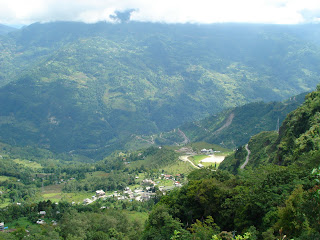Published in "The Hindu Business Line"
Bliss Divine: Pelling
It is the second week of June and dense fog shrouds the surrounds as we wend our way from our base at Gangtok, to Pelling, West Sikkim. It is obvious that Longfu, a genial native who has been chauffering us around for a week now in this mystical paradise is unperturbed by the thick white veil as he manoeuvres the Indica deftly through winding roads, hairpin bends and sharp curves.
The magic of Sikkim unfolds before us as we make our way through breathtaking terrains that are a heady mixture of rolling tea gardens, luxuriant blossom-ridden valleys, ice-capped, rugged mountains, deep gorges, gurgling streams and gushing waterfalls of varying heights. If nature presents itself in fascinating colours, its people, sporting flamboyant costumes, are just as charming and hospitable. And we get to see their friendliness in ample measure in Longfu too, who is constantly making sure that we are comfortable through our stay and sojourns in Sikkim.
As we get closer to Pelling, the views of India’s highest and the world’s third highest peak, the towering Kangchendzonga or Kanchenjunga at 28,169 feet, appears to close in upon us. Though we do get to view the Himalayan peak from almost anywhere in this tiny state, we realize that it is from Pelling that we get some of best, most uninterrupted views of the mighty range. Of course the mist plays hide and seek with us every few minutes, but we do get to savour the giant peak at least for a few moments without the snowy drape.
While Pelling itself is a tiny nondescript village dotted with typical mountain dwellings, and several upclass hotels and fast food outlets, it is a takeoff point for Khechoepalri Lake, Pemayanste and Sango Choling Monasteries, Kangchendzonga and other waterfalls, Tashiding and Yoksum. After halting for a steaming cup of ginger chai at one of the dhabas, we first head towards Khechoepalri Lake, also known as the Wishing Lake, about 6km away. The serene ambience of the lake, festooned by fluttering prayer flags, is enveloped by greenery. Legend has it that this place was once a grazing ground abounding with stinging nettle, the bark of which the native Lepchas used for various purposes. One day when a Lepcha couple was peeling off the bark, they observed a pair of conch shells plummet at great speed earthwards, pierce the ground and embed into it. The ground trembled violently and thus sprung from it a gigantic well of water that soon spread itself into a lake. The lake, according to Buddhist belief, assumed the shape of the footprint of goddess Tara was considered as the abode of Tshoman Gyalmo or chief protective nymph of the Dharma as blessed by the goddess. Deemed sacred, the lake thus began to be worshipped. Another interesting story associated with the lake is that its sanctity is not only recognized by the avian creatures but the birds also help to keep it clean. Hence none of the falling leaves or foliages from the cornucopia of trees surrounding the lake float on its waters beyond a few minutes since they are pecked off by the soaring, swooping birds in a cleanup act.
Whatever the tales or beliefs, there is a blissful and divine calm that we enjoy in its precincts that includes colorful monastic dwellings. Even as we enjoy the tranquil environs, there are several other tourists who amble along the walkway leading to the edge of the lake, turning the series of prayer wheels as they walk along the path. But for the sound of cameras clicking away, there is perfect silence, meditative and spiritual in effect.
We halfheartedly pull ourselves away from this magical spell cast by the lake and proceed towards Pemayanste, a few kilometers away, at an altitude of 6840 feet. A couple of well fed canines wag their tails in greeting as we enter its portals. Longfu who also doubles up as guide tells us that the monastery is the most important one of the Nyingmapa order of Buddhism and was originally built as a small temple by Latsun Chembo in the late 17th century. It was only during the period of the third Chogyal Chakdor Namgyal, Jigme Pawo, that it came to be restructured in its present, bigger scale. The three-storeyed structure houses several idols, scriptures and objects, priceless for their antiquity. The most predominant feature of Pemayanste as the other monasteries in and around Pelling and in Sikkim itself, is the color within – bright without being loud or garish.
The day progresses to pre-dusk as we reach Kanchengdzonga Waterfalls, about 15km from Pelling en route Yoksum which we give a skip, reserving it for another time. A few hundred metres away from our approach to the waterfalls we can hear the thundering symphony of its tumbling waters. We thrill at the dazzling play of the frothy water against a reluctant sun as it cascades down the granite rocks, its droplets settling gently on our being like shiny specs of pearls.
Unfortunately for us, a mild drizzle that began some moments ago, escalates to a medium shower, forcing me to abandon my antics with the camera. As I enjoy nature’s aqueous drama, I rest content with the couple of shots I managed prior to the downpour, thanking the rain gods for delaying their grand entry to coincide with the fag end of our Sikkim trip.
***********




No comments:
Post a Comment